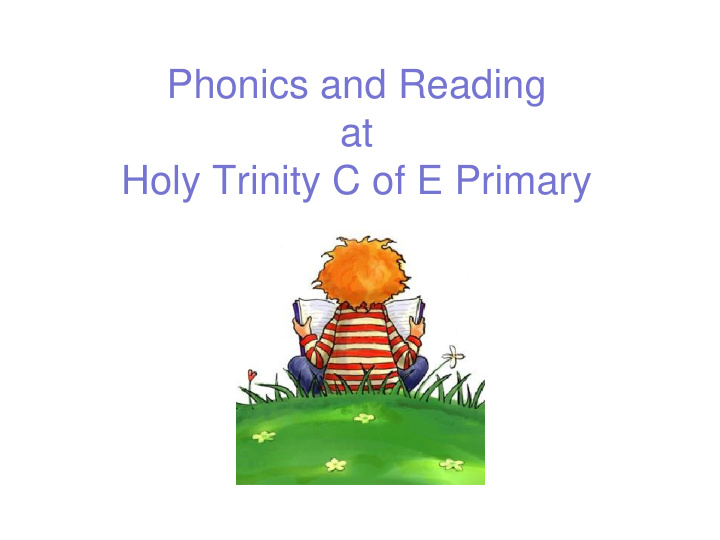



Phonics and Reading at Holy Trinity C of E Primary
What is Phonics? • Identifying sounds in spoken words • Recognising the common spellings of each phoneme • Blending phonemes into words for reading • Segmenting words into phonemes for spelling
Some definitions - Phonemes • A phoneme is the smallest unit of sound in a word How many phonemes can you hear in cat ?
Graphemes • These are the letters that represent the phoneme. • The grapheme could be 1 letter, 2 letters or more! We refer to these as sound buttons.
Blending (for reading) • Recognising the letter sounds in a written word e.g. c-u-p, sh-ee-p. • Merging them in the correct order to pronounce the word cup and sheep.
Segmenting (for spelling) • Identifying the individual sounds in a spoken word (e.g. h-i-m, s-t-or-k) and writing down letters for each sound (phoneme) to form the word him and stork.
How is Phonics taught at Holy Trinity? • We follow the ‘Letters and Sounds’ document which is split into 6 distinct phases
Phase 1 • Showing an awareness of rhyme and alliteration • Distinguishing between sounds in the environment and phonemes • Exploring and experimenting with sounds and words • Discriminating speech sounds in words • Beginning to orally blend and segment phonemes
Phase 2 • Using common consonants and vowels • Blending for reading and segmenting for spelling simple cvc words • Understanding that words are constructed from phonemes and that phonemes are represented by graphemes • Approximately 3 sounds a week
Letter sets Set 1 - s, a, t, p, Set 2 - i, n, m, d, Set 3 - g, o, c, k, Set 4 - ck, e, u, r, Set 5 - h, b, f, ff, l, ll, ss,
Phase 3 • Reading and spelling a wide range of cvc words • Using all letters, some consonant digraphs (ch, sh, th, ng) and some long vowel phonemes
Phase 4 • This is a consolidation unit. There are no new graphemes to learn. Reading and spelling of tricky words continue • There is more of a focus on cvcc and ccvc words
Phase 5 • Reading phonetically decodable two-syllable and three-syllable words • Using alternative ways of pronouncing and spelling the graphemes corresponding to the long vowel phonemes • Spelling complex words using phonetically plausible attempts
Year 1 Phonics Screening Check • Takes place in June • Children will read 40 words which are a mixture of real and nonsense words
Phase 6 • Recognising phonic irregularities and becoming more secure with less common grapheme- phoneme correspondences • Applying phonic skills and knowledge to recognise and spell an increasing number of complex words • Introducing and teaching the past tense • Investigating and learning how to add suffixes
Tricky Words • Regularly the children learn ‘tricky’ words (those that are not all spelt phonetically) and key sight vocabulary. were there little one help • The learning of tricky words will be supported at home through practising Spelling Star words
Helping at home Common Objects Making Sentences Jumble up sentences from your child’s reading book. Collect several objects that begin with the same Odd-one Out sound. Which Say a number of words, all but starts with one of which begin with the a different sound to the same sound. See if your child others? can pick out the odd one.
Web-based activities • www.phonicsplay.co.uk • http://www.ictgames.com/literacy.html • http://www.topmarks.co.uk/Interactive.asp x?cat=40 • https://www.bbc.co.uk/cbeebies/shows/alp hablocks • Mr Thorne – YouTube content
Any questions?
Recommend
More recommend